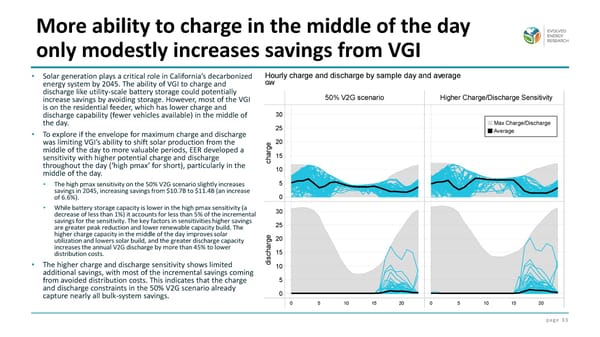page 33 • Solar generation plays a critical role in California’s decarbonized energy system by 2045. The ability of VGI to charge and discharge like utility-scale battery storage could potentially increase savings by avoiding storage. However, most of the VGI is on the residential feeder, which has lower charge and discharge capability (fewer vehicles available) in the middle of the day. • To explore if the envelope for maximum charge and discharge was limiting VGI’s ability to shift solar production from the middle of the day to more valuable periods, EER developed a sensitivity with higher potential charge and discharge throughout the day (‘high pmax’ for short), particularly in the middle of the day. • The high pmax sensitivity on the 50% V2G scenario slightly increases savings in 2045, increasing savings from $10.7B to $11.4B (an increase of 6.6%). • While battery storage capacity is lower in the high pmax sensitivity (a decrease of less than 1%) it accounts for less than 5% of the incremental savings for the sensitivity. The key factors in sensitivities higher savings are greater peak reduction and lower renewable capacity build. The higher charge capacity in the middle of the day improves solar utilization and lowers solar build, and the greater discharge capacity increases the annual V2G discharge by more than 45% to lower distribution costs. • The higher charge and discharge sensitivity shows limited additional savings, with most of the incremental savings coming from avoided distribution costs. This indicates that the charge and discharge constraints in the 50% V2G scenario already capture nearly all bulk-system savings. More ability to charge in the middle of the day only modestly increases savings from VGI
 Exploring the Value of Vehicle to Grid (V2G) for California Page 32 Page 34
Exploring the Value of Vehicle to Grid (V2G) for California Page 32 Page 34